Microbiology Assignment: Proteomics and E. coli Characterization
VerifiedAdded on 2021/06/17
|14
|3742
|99
Report
AI Summary
This report delves into the application of proteomics in characterizing Escherichia coli (E. coli), a significant foodborne pathogen. It defines proteomics and describes E. coli, highlighting its importance and various strains, including harmless and pathogenic types. The report explores the use of proteomics in identifying proteins, understanding physiological conditions, and characterizing the E. coli proteome, including membrane proteins. It discusses the different pathotypes of E. coli, such as ETEC, EPEC, EHEC, EIEC, EAEC, and AIEC, and their associated pathogenicity pathways. Furthermore, it covers the pathways related to pathogenicity and stress responses. The report also provides a historical overview of proteomic analysis of E. coli and how understanding has evolved over time, including the challenges associated with membrane protein characterization. The study emphasizes the significance of proteomics in understanding the complex nature of E. coli and its impact on human health, especially in relation to foodborne illnesses.

Running head: MICROBIOLOGY
Use of proteomics in characterizing E. Coli
Name of the student:
Name of the University:
Author Note:
Use of proteomics in characterizing E. Coli
Name of the student:
Name of the University:
Author Note:
Paraphrase This Document
Need a fresh take? Get an instant paraphrase of this document with our AI Paraphraser
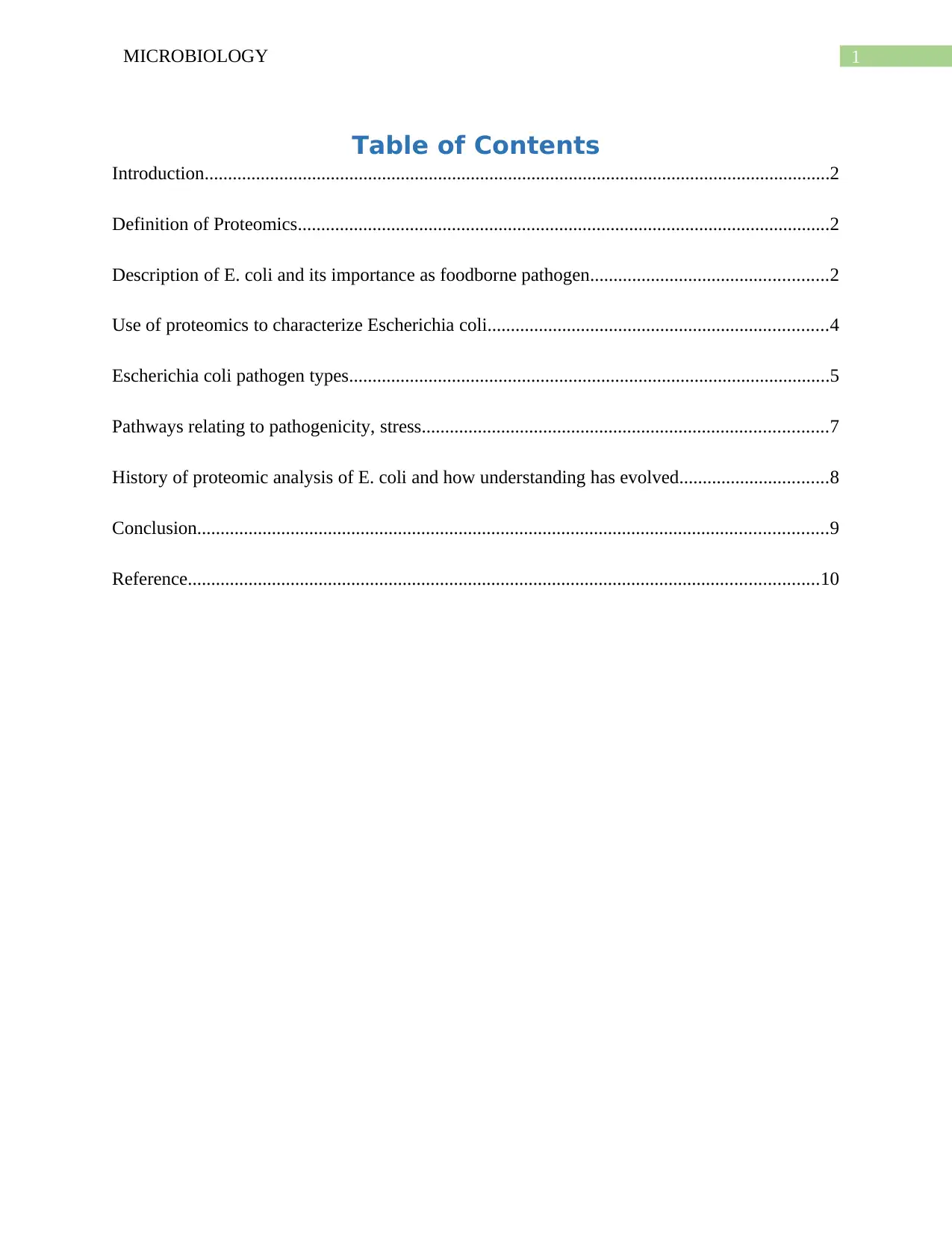
1MICROBIOLOGY
Table of Contents
Introduction......................................................................................................................................2
Definition of Proteomics..................................................................................................................2
Description of E. coli and its importance as foodborne pathogen...................................................2
Use of proteomics to characterize Escherichia coli.........................................................................4
Escherichia coli pathogen types.......................................................................................................5
Pathways relating to pathogenicity, stress.......................................................................................7
History of proteomic analysis of E. coli and how understanding has evolved................................8
Conclusion.......................................................................................................................................9
Reference.......................................................................................................................................10
Table of Contents
Introduction......................................................................................................................................2
Definition of Proteomics..................................................................................................................2
Description of E. coli and its importance as foodborne pathogen...................................................2
Use of proteomics to characterize Escherichia coli.........................................................................4
Escherichia coli pathogen types.......................................................................................................5
Pathways relating to pathogenicity, stress.......................................................................................7
History of proteomic analysis of E. coli and how understanding has evolved................................8
Conclusion.......................................................................................................................................9
Reference.......................................................................................................................................10
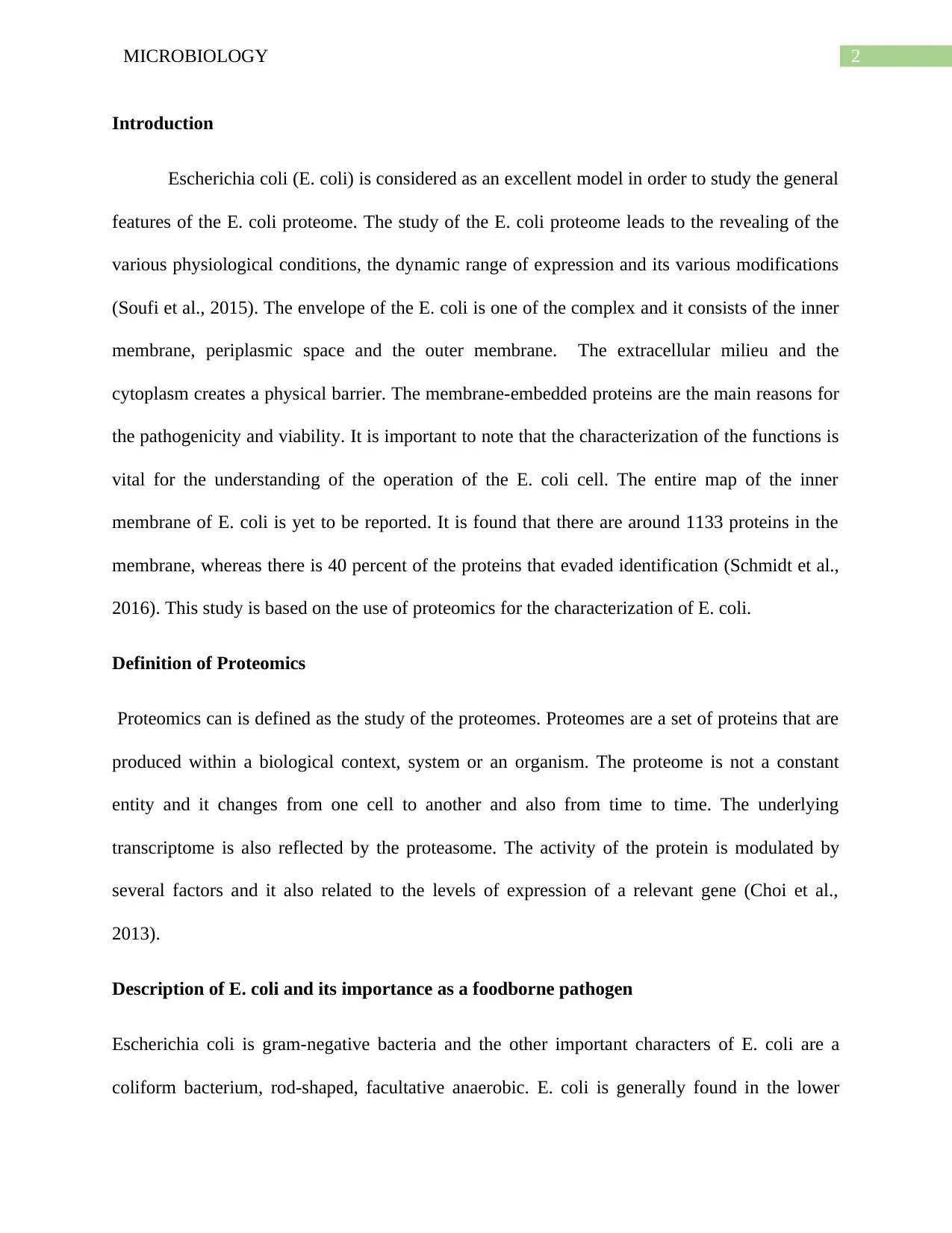
2MICROBIOLOGY
Introduction
Escherichia coli (E. coli) is considered as an excellent model in order to study the general
features of the E. coli proteome. The study of the E. coli proteome leads to the revealing of the
various physiological conditions, the dynamic range of expression and its various modifications
(Soufi et al., 2015). The envelope of the E. coli is one of the complex and it consists of the inner
membrane, periplasmic space and the outer membrane. The extracellular milieu and the
cytoplasm creates a physical barrier. The membrane-embedded proteins are the main reasons for
the pathogenicity and viability. It is important to note that the characterization of the functions is
vital for the understanding of the operation of the E. coli cell. The entire map of the inner
membrane of E. coli is yet to be reported. It is found that there are around 1133 proteins in the
membrane, whereas there is 40 percent of the proteins that evaded identification (Schmidt et al.,
2016). This study is based on the use of proteomics for the characterization of E. coli.
Definition of Proteomics
Proteomics can is defined as the study of the proteomes. Proteomes are a set of proteins that are
produced within a biological context, system or an organism. The proteome is not a constant
entity and it changes from one cell to another and also from time to time. The underlying
transcriptome is also reflected by the proteasome. The activity of the protein is modulated by
several factors and it also related to the levels of expression of a relevant gene (Choi et al.,
2013).
Description of E. coli and its importance as a foodborne pathogen
Escherichia coli is gram-negative bacteria and the other important characters of E. coli are a
coliform bacterium, rod-shaped, facultative anaerobic. E. coli is generally found in the lower
Introduction
Escherichia coli (E. coli) is considered as an excellent model in order to study the general
features of the E. coli proteome. The study of the E. coli proteome leads to the revealing of the
various physiological conditions, the dynamic range of expression and its various modifications
(Soufi et al., 2015). The envelope of the E. coli is one of the complex and it consists of the inner
membrane, periplasmic space and the outer membrane. The extracellular milieu and the
cytoplasm creates a physical barrier. The membrane-embedded proteins are the main reasons for
the pathogenicity and viability. It is important to note that the characterization of the functions is
vital for the understanding of the operation of the E. coli cell. The entire map of the inner
membrane of E. coli is yet to be reported. It is found that there are around 1133 proteins in the
membrane, whereas there is 40 percent of the proteins that evaded identification (Schmidt et al.,
2016). This study is based on the use of proteomics for the characterization of E. coli.
Definition of Proteomics
Proteomics can is defined as the study of the proteomes. Proteomes are a set of proteins that are
produced within a biological context, system or an organism. The proteome is not a constant
entity and it changes from one cell to another and also from time to time. The underlying
transcriptome is also reflected by the proteasome. The activity of the protein is modulated by
several factors and it also related to the levels of expression of a relevant gene (Choi et al.,
2013).
Description of E. coli and its importance as a foodborne pathogen
Escherichia coli is gram-negative bacteria and the other important characters of E. coli are a
coliform bacterium, rod-shaped, facultative anaerobic. E. coli is generally found in the lower
⊘ This is a preview!⊘
Do you want full access?
Subscribe today to unlock all pages.

Trusted by 1+ million students worldwide
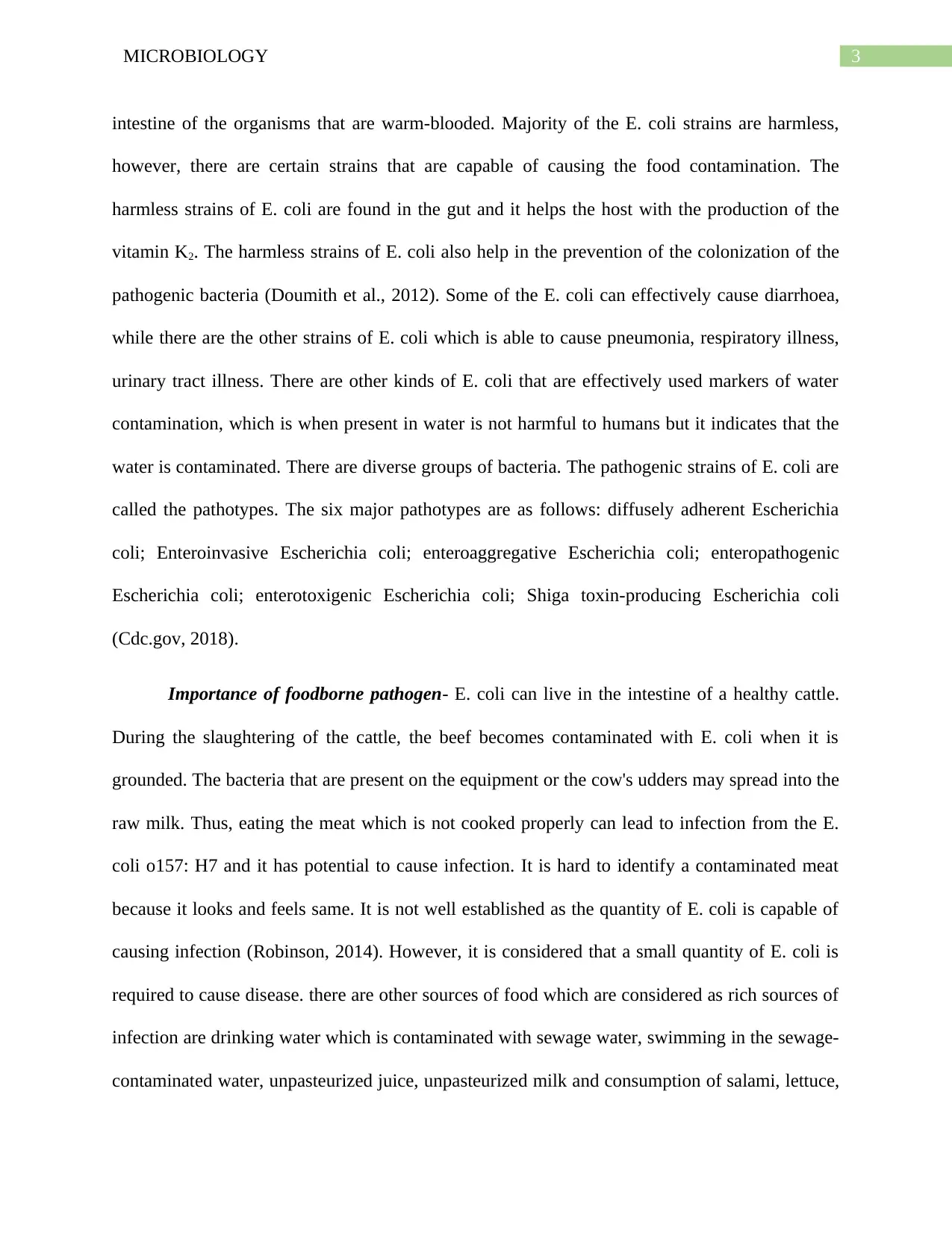
3MICROBIOLOGY
intestine of the organisms that are warm-blooded. Majority of the E. coli strains are harmless,
however, there are certain strains that are capable of causing the food contamination. The
harmless strains of E. coli are found in the gut and it helps the host with the production of the
vitamin K2. The harmless strains of E. coli also help in the prevention of the colonization of the
pathogenic bacteria (Doumith et al., 2012). Some of the E. coli can effectively cause diarrhoea,
while there are the other strains of E. coli which is able to cause pneumonia, respiratory illness,
urinary tract illness. There are other kinds of E. coli that are effectively used markers of water
contamination, which is when present in water is not harmful to humans but it indicates that the
water is contaminated. There are diverse groups of bacteria. The pathogenic strains of E. coli are
called the pathotypes. The six major pathotypes are as follows: diffusely adherent Escherichia
coli; Enteroinvasive Escherichia coli; enteroaggregative Escherichia coli; enteropathogenic
Escherichia coli; enterotoxigenic Escherichia coli; Shiga toxin-producing Escherichia coli
(Cdc.gov, 2018).
Importance of foodborne pathogen- E. coli can live in the intestine of a healthy cattle.
During the slaughtering of the cattle, the beef becomes contaminated with E. coli when it is
grounded. The bacteria that are present on the equipment or the cow's udders may spread into the
raw milk. Thus, eating the meat which is not cooked properly can lead to infection from the E.
coli o157: H7 and it has potential to cause infection. It is hard to identify a contaminated meat
because it looks and feels same. It is not well established as the quantity of E. coli is capable of
causing infection (Robinson, 2014). However, it is considered that a small quantity of E. coli is
required to cause disease. there are other sources of food which are considered as rich sources of
infection are drinking water which is contaminated with sewage water, swimming in the sewage-
contaminated water, unpasteurized juice, unpasteurized milk and consumption of salami, lettuce,
intestine of the organisms that are warm-blooded. Majority of the E. coli strains are harmless,
however, there are certain strains that are capable of causing the food contamination. The
harmless strains of E. coli are found in the gut and it helps the host with the production of the
vitamin K2. The harmless strains of E. coli also help in the prevention of the colonization of the
pathogenic bacteria (Doumith et al., 2012). Some of the E. coli can effectively cause diarrhoea,
while there are the other strains of E. coli which is able to cause pneumonia, respiratory illness,
urinary tract illness. There are other kinds of E. coli that are effectively used markers of water
contamination, which is when present in water is not harmful to humans but it indicates that the
water is contaminated. There are diverse groups of bacteria. The pathogenic strains of E. coli are
called the pathotypes. The six major pathotypes are as follows: diffusely adherent Escherichia
coli; Enteroinvasive Escherichia coli; enteroaggregative Escherichia coli; enteropathogenic
Escherichia coli; enterotoxigenic Escherichia coli; Shiga toxin-producing Escherichia coli
(Cdc.gov, 2018).
Importance of foodborne pathogen- E. coli can live in the intestine of a healthy cattle.
During the slaughtering of the cattle, the beef becomes contaminated with E. coli when it is
grounded. The bacteria that are present on the equipment or the cow's udders may spread into the
raw milk. Thus, eating the meat which is not cooked properly can lead to infection from the E.
coli o157: H7 and it has potential to cause infection. It is hard to identify a contaminated meat
because it looks and feels same. It is not well established as the quantity of E. coli is capable of
causing infection (Robinson, 2014). However, it is considered that a small quantity of E. coli is
required to cause disease. there are other sources of food which are considered as rich sources of
infection are drinking water which is contaminated with sewage water, swimming in the sewage-
contaminated water, unpasteurized juice, unpasteurized milk and consumption of salami, lettuce,
Paraphrase This Document
Need a fresh take? Get an instant paraphrase of this document with our AI Paraphraser
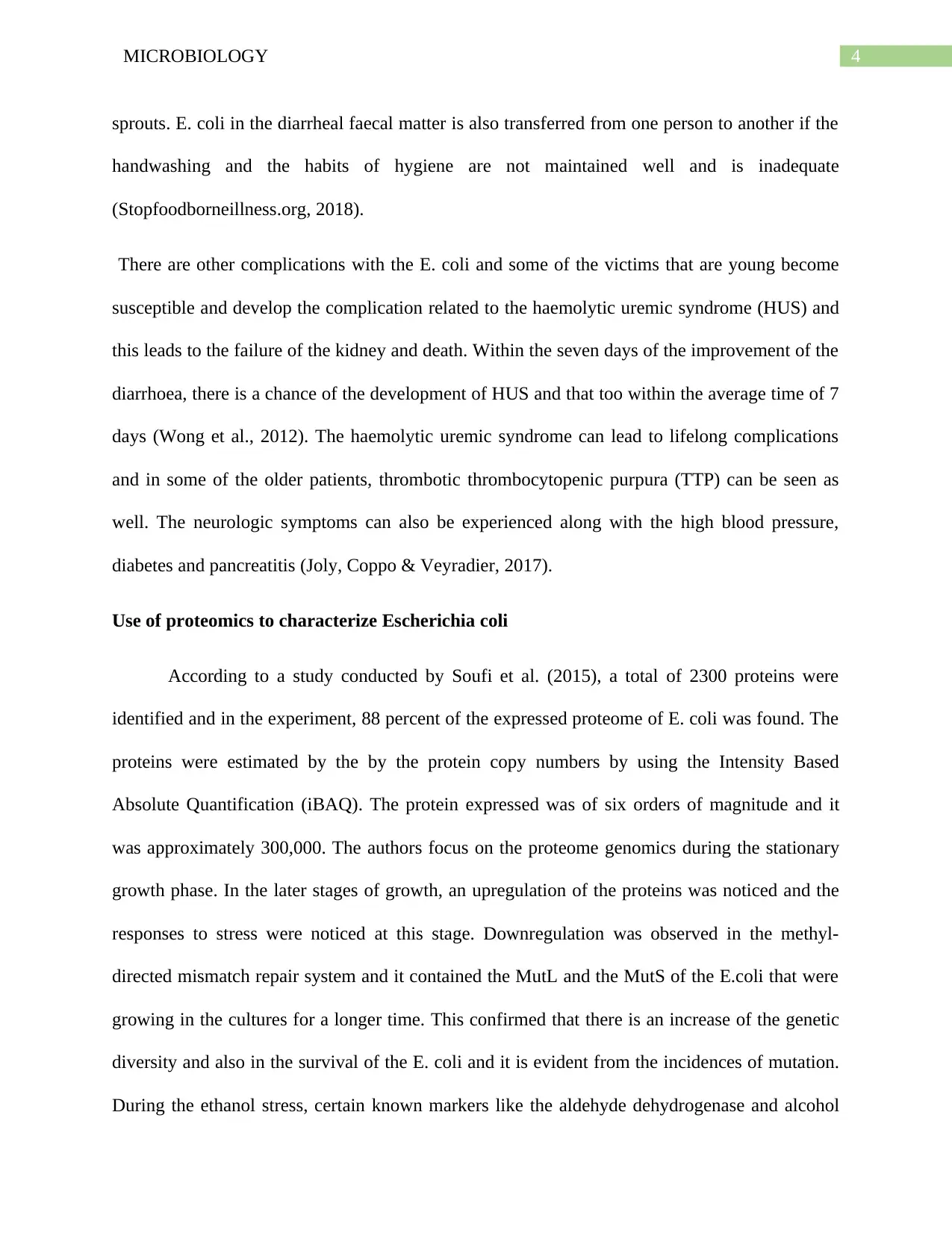
4MICROBIOLOGY
sprouts. E. coli in the diarrheal faecal matter is also transferred from one person to another if the
handwashing and the habits of hygiene are not maintained well and is inadequate
(Stopfoodborneillness.org, 2018).
There are other complications with the E. coli and some of the victims that are young become
susceptible and develop the complication related to the haemolytic uremic syndrome (HUS) and
this leads to the failure of the kidney and death. Within the seven days of the improvement of the
diarrhoea, there is a chance of the development of HUS and that too within the average time of 7
days (Wong et al., 2012). The haemolytic uremic syndrome can lead to lifelong complications
and in some of the older patients, thrombotic thrombocytopenic purpura (TTP) can be seen as
well. The neurologic symptoms can also be experienced along with the high blood pressure,
diabetes and pancreatitis (Joly, Coppo & Veyradier, 2017).
Use of proteomics to characterize Escherichia coli
According to a study conducted by Soufi et al. (2015), a total of 2300 proteins were
identified and in the experiment, 88 percent of the expressed proteome of E. coli was found. The
proteins were estimated by the by the protein copy numbers by using the Intensity Based
Absolute Quantification (iBAQ). The protein expressed was of six orders of magnitude and it
was approximately 300,000. The authors focus on the proteome genomics during the stationary
growth phase. In the later stages of growth, an upregulation of the proteins was noticed and the
responses to stress were noticed at this stage. Downregulation was observed in the methyl-
directed mismatch repair system and it contained the MutL and the MutS of the E.coli that were
growing in the cultures for a longer time. This confirmed that there is an increase of the genetic
diversity and also in the survival of the E. coli and it is evident from the incidences of mutation.
During the ethanol stress, certain known markers like the aldehyde dehydrogenase and alcohol
sprouts. E. coli in the diarrheal faecal matter is also transferred from one person to another if the
handwashing and the habits of hygiene are not maintained well and is inadequate
(Stopfoodborneillness.org, 2018).
There are other complications with the E. coli and some of the victims that are young become
susceptible and develop the complication related to the haemolytic uremic syndrome (HUS) and
this leads to the failure of the kidney and death. Within the seven days of the improvement of the
diarrhoea, there is a chance of the development of HUS and that too within the average time of 7
days (Wong et al., 2012). The haemolytic uremic syndrome can lead to lifelong complications
and in some of the older patients, thrombotic thrombocytopenic purpura (TTP) can be seen as
well. The neurologic symptoms can also be experienced along with the high blood pressure,
diabetes and pancreatitis (Joly, Coppo & Veyradier, 2017).
Use of proteomics to characterize Escherichia coli
According to a study conducted by Soufi et al. (2015), a total of 2300 proteins were
identified and in the experiment, 88 percent of the expressed proteome of E. coli was found. The
proteins were estimated by the by the protein copy numbers by using the Intensity Based
Absolute Quantification (iBAQ). The protein expressed was of six orders of magnitude and it
was approximately 300,000. The authors focus on the proteome genomics during the stationary
growth phase. In the later stages of growth, an upregulation of the proteins was noticed and the
responses to stress were noticed at this stage. Downregulation was observed in the methyl-
directed mismatch repair system and it contained the MutL and the MutS of the E.coli that were
growing in the cultures for a longer time. This confirmed that there is an increase of the genetic
diversity and also in the survival of the E. coli and it is evident from the incidences of mutation.
During the ethanol stress, certain known markers like the aldehyde dehydrogenase and alcohol
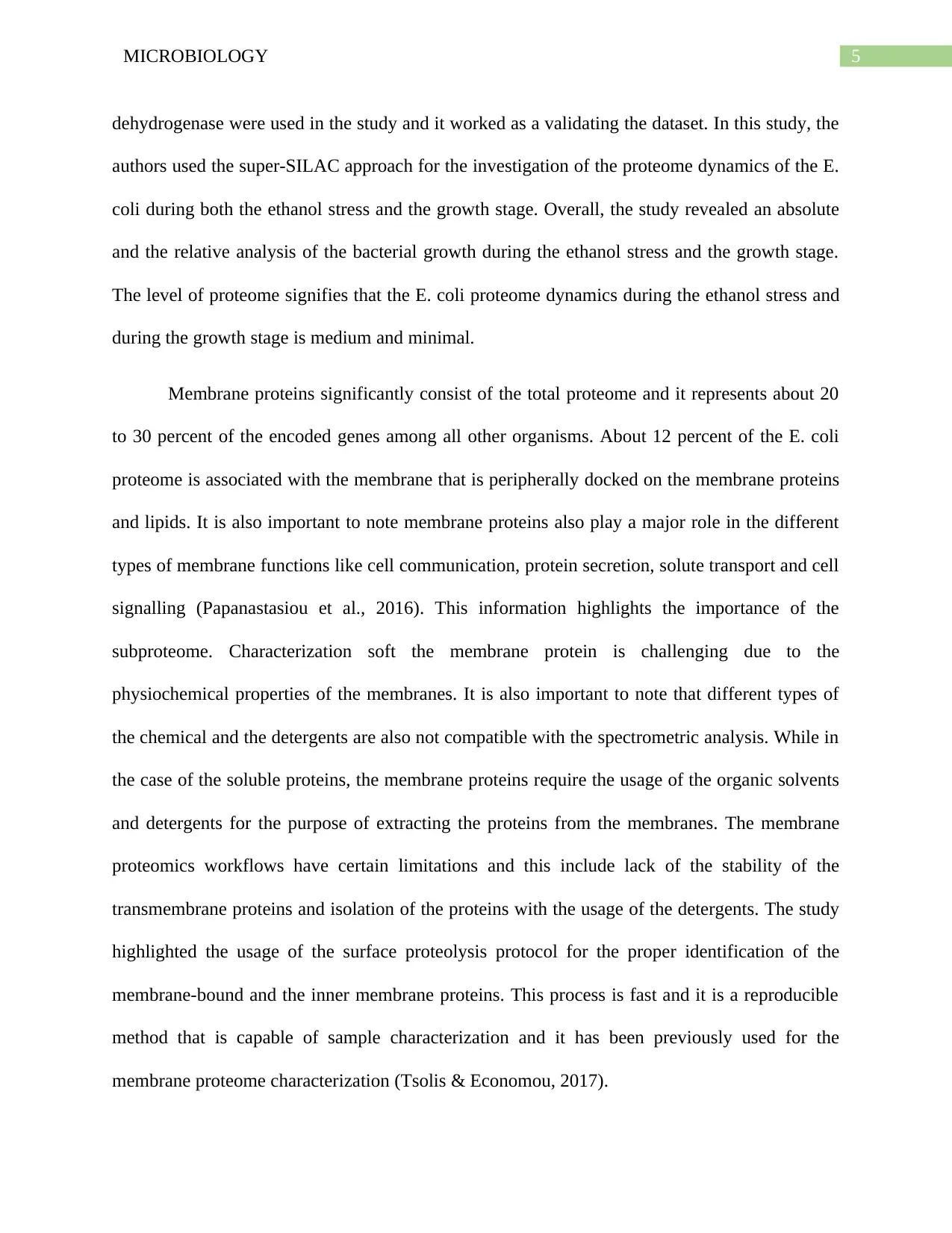
5MICROBIOLOGY
dehydrogenase were used in the study and it worked as a validating the dataset. In this study, the
authors used the super-SILAC approach for the investigation of the proteome dynamics of the E.
coli during both the ethanol stress and the growth stage. Overall, the study revealed an absolute
and the relative analysis of the bacterial growth during the ethanol stress and the growth stage.
The level of proteome signifies that the E. coli proteome dynamics during the ethanol stress and
during the growth stage is medium and minimal.
Membrane proteins significantly consist of the total proteome and it represents about 20
to 30 percent of the encoded genes among all other organisms. About 12 percent of the E. coli
proteome is associated with the membrane that is peripherally docked on the membrane proteins
and lipids. It is also important to note membrane proteins also play a major role in the different
types of membrane functions like cell communication, protein secretion, solute transport and cell
signalling (Papanastasiou et al., 2016). This information highlights the importance of the
subproteome. Characterization soft the membrane protein is challenging due to the
physiochemical properties of the membranes. It is also important to note that different types of
the chemical and the detergents are also not compatible with the spectrometric analysis. While in
the case of the soluble proteins, the membrane proteins require the usage of the organic solvents
and detergents for the purpose of extracting the proteins from the membranes. The membrane
proteomics workflows have certain limitations and this include lack of the stability of the
transmembrane proteins and isolation of the proteins with the usage of the detergents. The study
highlighted the usage of the surface proteolysis protocol for the proper identification of the
membrane-bound and the inner membrane proteins. This process is fast and it is a reproducible
method that is capable of sample characterization and it has been previously used for the
membrane proteome characterization (Tsolis & Economou, 2017).
dehydrogenase were used in the study and it worked as a validating the dataset. In this study, the
authors used the super-SILAC approach for the investigation of the proteome dynamics of the E.
coli during both the ethanol stress and the growth stage. Overall, the study revealed an absolute
and the relative analysis of the bacterial growth during the ethanol stress and the growth stage.
The level of proteome signifies that the E. coli proteome dynamics during the ethanol stress and
during the growth stage is medium and minimal.
Membrane proteins significantly consist of the total proteome and it represents about 20
to 30 percent of the encoded genes among all other organisms. About 12 percent of the E. coli
proteome is associated with the membrane that is peripherally docked on the membrane proteins
and lipids. It is also important to note membrane proteins also play a major role in the different
types of membrane functions like cell communication, protein secretion, solute transport and cell
signalling (Papanastasiou et al., 2016). This information highlights the importance of the
subproteome. Characterization soft the membrane protein is challenging due to the
physiochemical properties of the membranes. It is also important to note that different types of
the chemical and the detergents are also not compatible with the spectrometric analysis. While in
the case of the soluble proteins, the membrane proteins require the usage of the organic solvents
and detergents for the purpose of extracting the proteins from the membranes. The membrane
proteomics workflows have certain limitations and this include lack of the stability of the
transmembrane proteins and isolation of the proteins with the usage of the detergents. The study
highlighted the usage of the surface proteolysis protocol for the proper identification of the
membrane-bound and the inner membrane proteins. This process is fast and it is a reproducible
method that is capable of sample characterization and it has been previously used for the
membrane proteome characterization (Tsolis & Economou, 2017).
⊘ This is a preview!⊘
Do you want full access?
Subscribe today to unlock all pages.

Trusted by 1+ million students worldwide
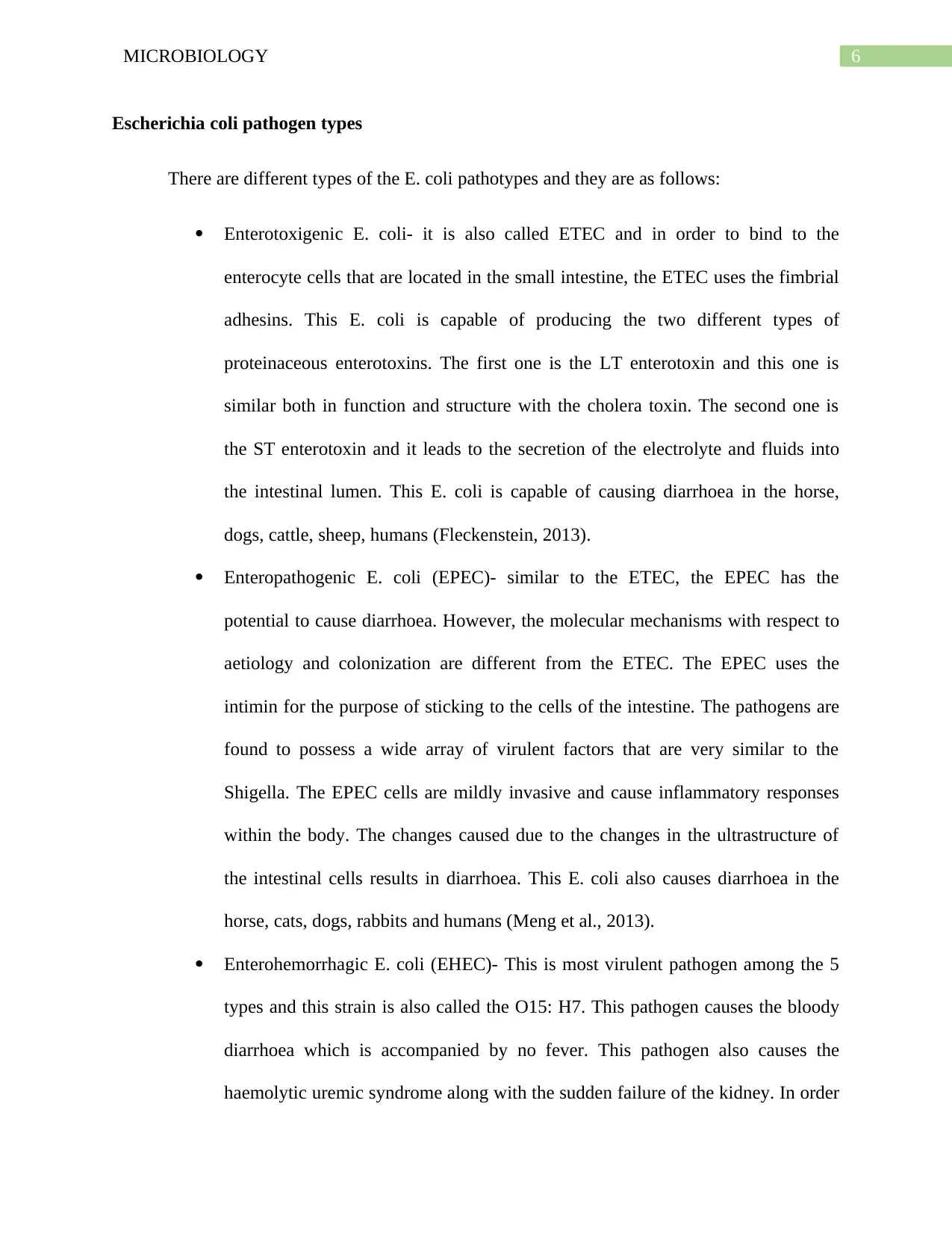
6MICROBIOLOGY
Escherichia coli pathogen types
There are different types of the E. coli pathotypes and they are as follows:
Enterotoxigenic E. coli- it is also called ETEC and in order to bind to the
enterocyte cells that are located in the small intestine, the ETEC uses the fimbrial
adhesins. This E. coli is capable of producing the two different types of
proteinaceous enterotoxins. The first one is the LT enterotoxin and this one is
similar both in function and structure with the cholera toxin. The second one is
the ST enterotoxin and it leads to the secretion of the electrolyte and fluids into
the intestinal lumen. This E. coli is capable of causing diarrhoea in the horse,
dogs, cattle, sheep, humans (Fleckenstein, 2013).
Enteropathogenic E. coli (EPEC)- similar to the ETEC, the EPEC has the
potential to cause diarrhoea. However, the molecular mechanisms with respect to
aetiology and colonization are different from the ETEC. The EPEC uses the
intimin for the purpose of sticking to the cells of the intestine. The pathogens are
found to possess a wide array of virulent factors that are very similar to the
Shigella. The EPEC cells are mildly invasive and cause inflammatory responses
within the body. The changes caused due to the changes in the ultrastructure of
the intestinal cells results in diarrhoea. This E. coli also causes diarrhoea in the
horse, cats, dogs, rabbits and humans (Meng et al., 2013).
Enterohemorrhagic E. coli (EHEC)- This is most virulent pathogen among the 5
types and this strain is also called the O15: H7. This pathogen causes the bloody
diarrhoea which is accompanied by no fever. This pathogen also causes the
haemolytic uremic syndrome along with the sudden failure of the kidney. In order
Escherichia coli pathogen types
There are different types of the E. coli pathotypes and they are as follows:
Enterotoxigenic E. coli- it is also called ETEC and in order to bind to the
enterocyte cells that are located in the small intestine, the ETEC uses the fimbrial
adhesins. This E. coli is capable of producing the two different types of
proteinaceous enterotoxins. The first one is the LT enterotoxin and this one is
similar both in function and structure with the cholera toxin. The second one is
the ST enterotoxin and it leads to the secretion of the electrolyte and fluids into
the intestinal lumen. This E. coli is capable of causing diarrhoea in the horse,
dogs, cattle, sheep, humans (Fleckenstein, 2013).
Enteropathogenic E. coli (EPEC)- similar to the ETEC, the EPEC has the
potential to cause diarrhoea. However, the molecular mechanisms with respect to
aetiology and colonization are different from the ETEC. The EPEC uses the
intimin for the purpose of sticking to the cells of the intestine. The pathogens are
found to possess a wide array of virulent factors that are very similar to the
Shigella. The EPEC cells are mildly invasive and cause inflammatory responses
within the body. The changes caused due to the changes in the ultrastructure of
the intestinal cells results in diarrhoea. This E. coli also causes diarrhoea in the
horse, cats, dogs, rabbits and humans (Meng et al., 2013).
Enterohemorrhagic E. coli (EHEC)- This is most virulent pathogen among the 5
types and this strain is also called the O15: H7. This pathogen causes the bloody
diarrhoea which is accompanied by no fever. This pathogen also causes the
haemolytic uremic syndrome along with the sudden failure of the kidney. In order
Paraphrase This Document
Need a fresh take? Get an instant paraphrase of this document with our AI Paraphraser
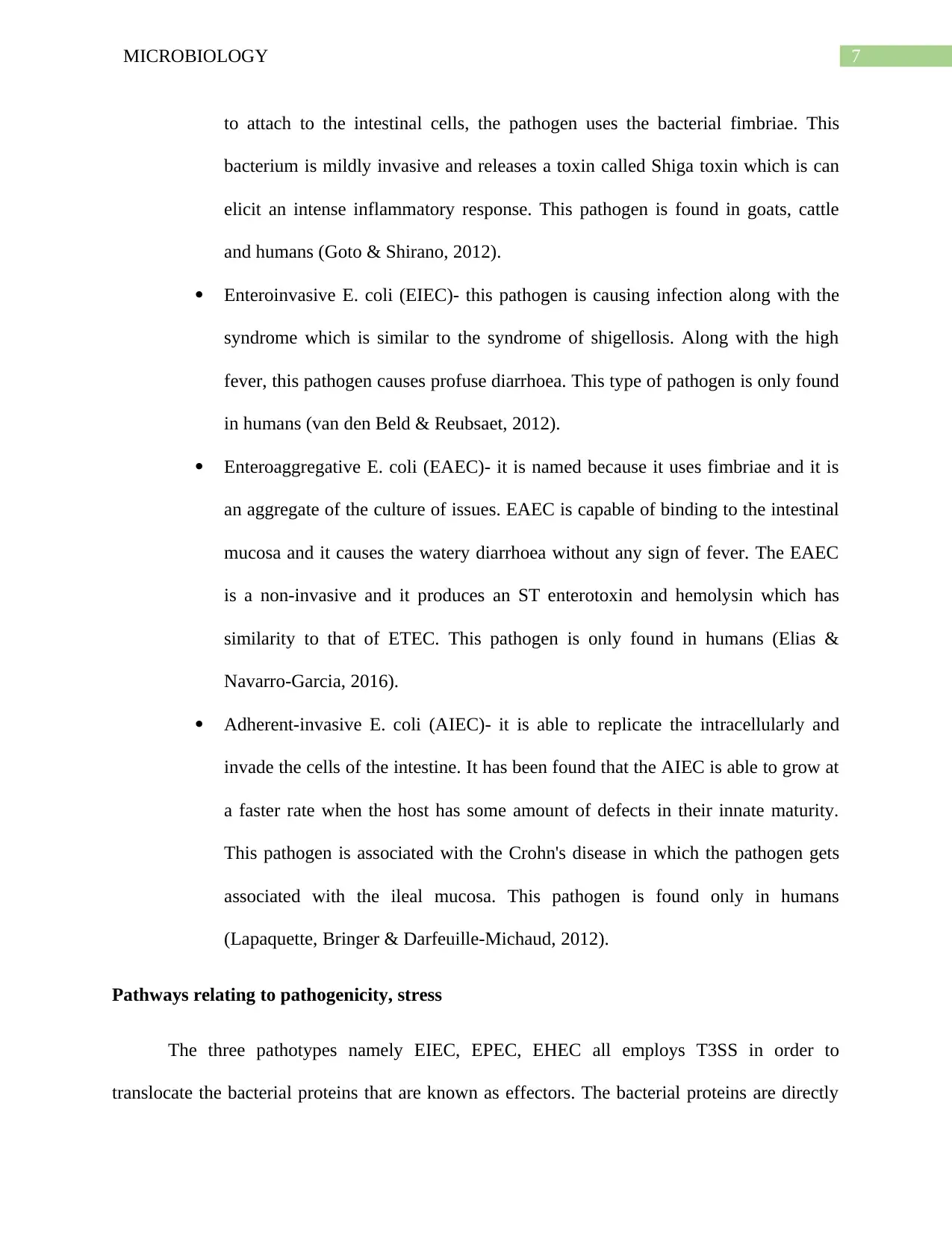
7MICROBIOLOGY
to attach to the intestinal cells, the pathogen uses the bacterial fimbriae. This
bacterium is mildly invasive and releases a toxin called Shiga toxin which is can
elicit an intense inflammatory response. This pathogen is found in goats, cattle
and humans (Goto & Shirano, 2012).
Enteroinvasive E. coli (EIEC)- this pathogen is causing infection along with the
syndrome which is similar to the syndrome of shigellosis. Along with the high
fever, this pathogen causes profuse diarrhoea. This type of pathogen is only found
in humans (van den Beld & Reubsaet, 2012).
Enteroaggregative E. coli (EAEC)- it is named because it uses fimbriae and it is
an aggregate of the culture of issues. EAEC is capable of binding to the intestinal
mucosa and it causes the watery diarrhoea without any sign of fever. The EAEC
is a non-invasive and it produces an ST enterotoxin and hemolysin which has
similarity to that of ETEC. This pathogen is only found in humans (Elias &
Navarro-Garcia, 2016).
Adherent-invasive E. coli (AIEC)- it is able to replicate the intracellularly and
invade the cells of the intestine. It has been found that the AIEC is able to grow at
a faster rate when the host has some amount of defects in their innate maturity.
This pathogen is associated with the Crohn's disease in which the pathogen gets
associated with the ileal mucosa. This pathogen is found only in humans
(Lapaquette, Bringer & Darfeuille‐Michaud, 2012).
Pathways relating to pathogenicity, stress
The three pathotypes namely EIEC, EPEC, EHEC all employs T3SS in order to
translocate the bacterial proteins that are known as effectors. The bacterial proteins are directly
to attach to the intestinal cells, the pathogen uses the bacterial fimbriae. This
bacterium is mildly invasive and releases a toxin called Shiga toxin which is can
elicit an intense inflammatory response. This pathogen is found in goats, cattle
and humans (Goto & Shirano, 2012).
Enteroinvasive E. coli (EIEC)- this pathogen is causing infection along with the
syndrome which is similar to the syndrome of shigellosis. Along with the high
fever, this pathogen causes profuse diarrhoea. This type of pathogen is only found
in humans (van den Beld & Reubsaet, 2012).
Enteroaggregative E. coli (EAEC)- it is named because it uses fimbriae and it is
an aggregate of the culture of issues. EAEC is capable of binding to the intestinal
mucosa and it causes the watery diarrhoea without any sign of fever. The EAEC
is a non-invasive and it produces an ST enterotoxin and hemolysin which has
similarity to that of ETEC. This pathogen is only found in humans (Elias &
Navarro-Garcia, 2016).
Adherent-invasive E. coli (AIEC)- it is able to replicate the intracellularly and
invade the cells of the intestine. It has been found that the AIEC is able to grow at
a faster rate when the host has some amount of defects in their innate maturity.
This pathogen is associated with the Crohn's disease in which the pathogen gets
associated with the ileal mucosa. This pathogen is found only in humans
(Lapaquette, Bringer & Darfeuille‐Michaud, 2012).
Pathways relating to pathogenicity, stress
The three pathotypes namely EIEC, EPEC, EHEC all employs T3SS in order to
translocate the bacterial proteins that are known as effectors. The bacterial proteins are directly
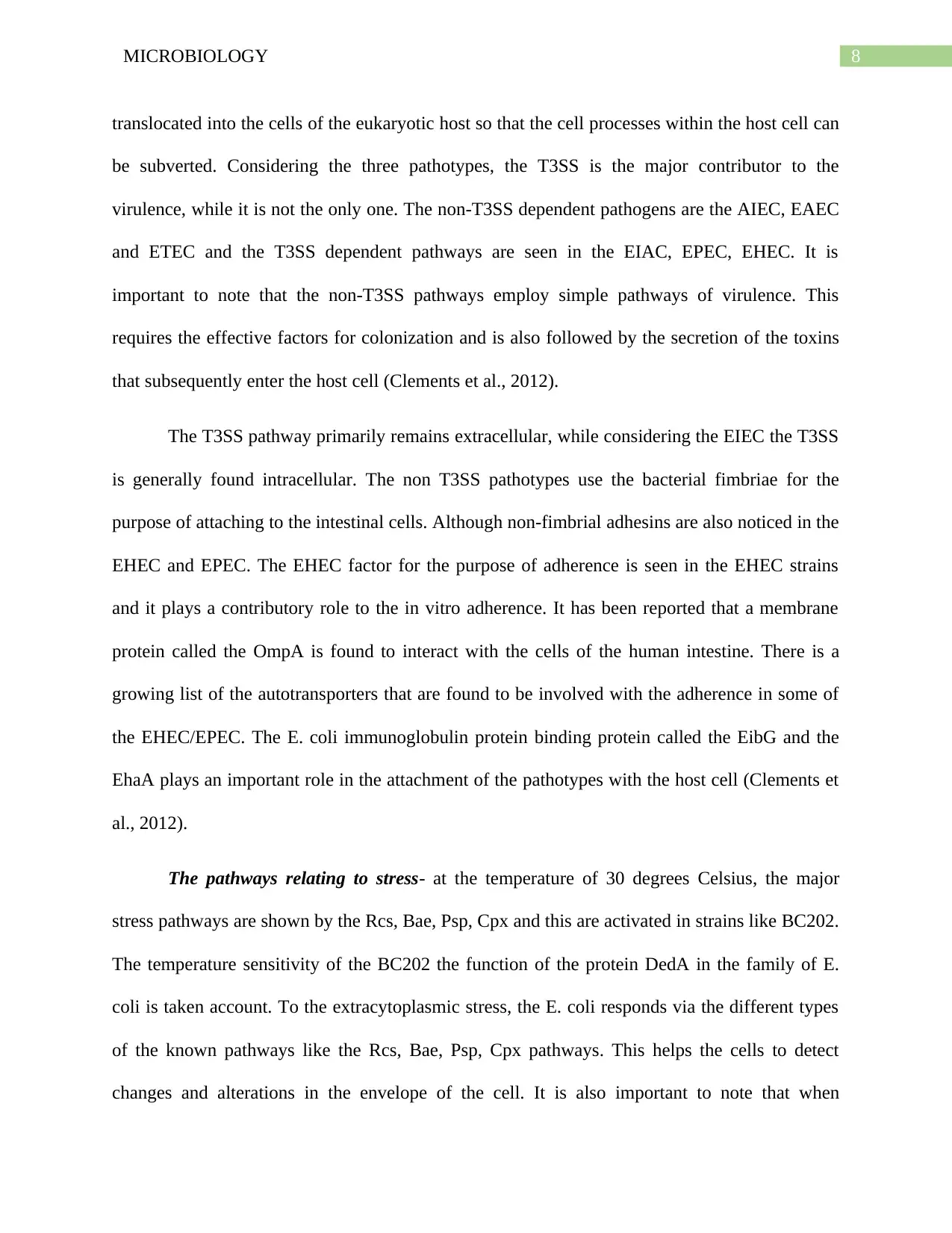
8MICROBIOLOGY
translocated into the cells of the eukaryotic host so that the cell processes within the host cell can
be subverted. Considering the three pathotypes, the T3SS is the major contributor to the
virulence, while it is not the only one. The non-T3SS dependent pathogens are the AIEC, EAEC
and ETEC and the T3SS dependent pathways are seen in the EIAC, EPEC, EHEC. It is
important to note that the non-T3SS pathways employ simple pathways of virulence. This
requires the effective factors for colonization and is also followed by the secretion of the toxins
that subsequently enter the host cell (Clements et al., 2012).
The T3SS pathway primarily remains extracellular, while considering the EIEC the T3SS
is generally found intracellular. The non T3SS pathotypes use the bacterial fimbriae for the
purpose of attaching to the intestinal cells. Although non-fimbrial adhesins are also noticed in the
EHEC and EPEC. The EHEC factor for the purpose of adherence is seen in the EHEC strains
and it plays a contributory role to the in vitro adherence. It has been reported that a membrane
protein called the OmpA is found to interact with the cells of the human intestine. There is a
growing list of the autotransporters that are found to be involved with the adherence in some of
the EHEC/EPEC. The E. coli immunoglobulin protein binding protein called the EibG and the
EhaA plays an important role in the attachment of the pathotypes with the host cell (Clements et
al., 2012).
The pathways relating to stress- at the temperature of 30 degrees Celsius, the major
stress pathways are shown by the Rcs, Bae, Psp, Cpx and this are activated in strains like BC202.
The temperature sensitivity of the BC202 the function of the protein DedA in the family of E.
coli is taken account. To the extracytoplasmic stress, the E. coli responds via the different types
of the known pathways like the Rcs, Bae, Psp, Cpx pathways. This helps the cells to detect
changes and alterations in the envelope of the cell. It is also important to note that when
translocated into the cells of the eukaryotic host so that the cell processes within the host cell can
be subverted. Considering the three pathotypes, the T3SS is the major contributor to the
virulence, while it is not the only one. The non-T3SS dependent pathogens are the AIEC, EAEC
and ETEC and the T3SS dependent pathways are seen in the EIAC, EPEC, EHEC. It is
important to note that the non-T3SS pathways employ simple pathways of virulence. This
requires the effective factors for colonization and is also followed by the secretion of the toxins
that subsequently enter the host cell (Clements et al., 2012).
The T3SS pathway primarily remains extracellular, while considering the EIEC the T3SS
is generally found intracellular. The non T3SS pathotypes use the bacterial fimbriae for the
purpose of attaching to the intestinal cells. Although non-fimbrial adhesins are also noticed in the
EHEC and EPEC. The EHEC factor for the purpose of adherence is seen in the EHEC strains
and it plays a contributory role to the in vitro adherence. It has been reported that a membrane
protein called the OmpA is found to interact with the cells of the human intestine. There is a
growing list of the autotransporters that are found to be involved with the adherence in some of
the EHEC/EPEC. The E. coli immunoglobulin protein binding protein called the EibG and the
EhaA plays an important role in the attachment of the pathotypes with the host cell (Clements et
al., 2012).
The pathways relating to stress- at the temperature of 30 degrees Celsius, the major
stress pathways are shown by the Rcs, Bae, Psp, Cpx and this are activated in strains like BC202.
The temperature sensitivity of the BC202 the function of the protein DedA in the family of E.
coli is taken account. To the extracytoplasmic stress, the E. coli responds via the different types
of the known pathways like the Rcs, Bae, Psp, Cpx pathways. This helps the cells to detect
changes and alterations in the envelope of the cell. It is also important to note that when
⊘ This is a preview!⊘
Do you want full access?
Subscribe today to unlock all pages.

Trusted by 1+ million students worldwide
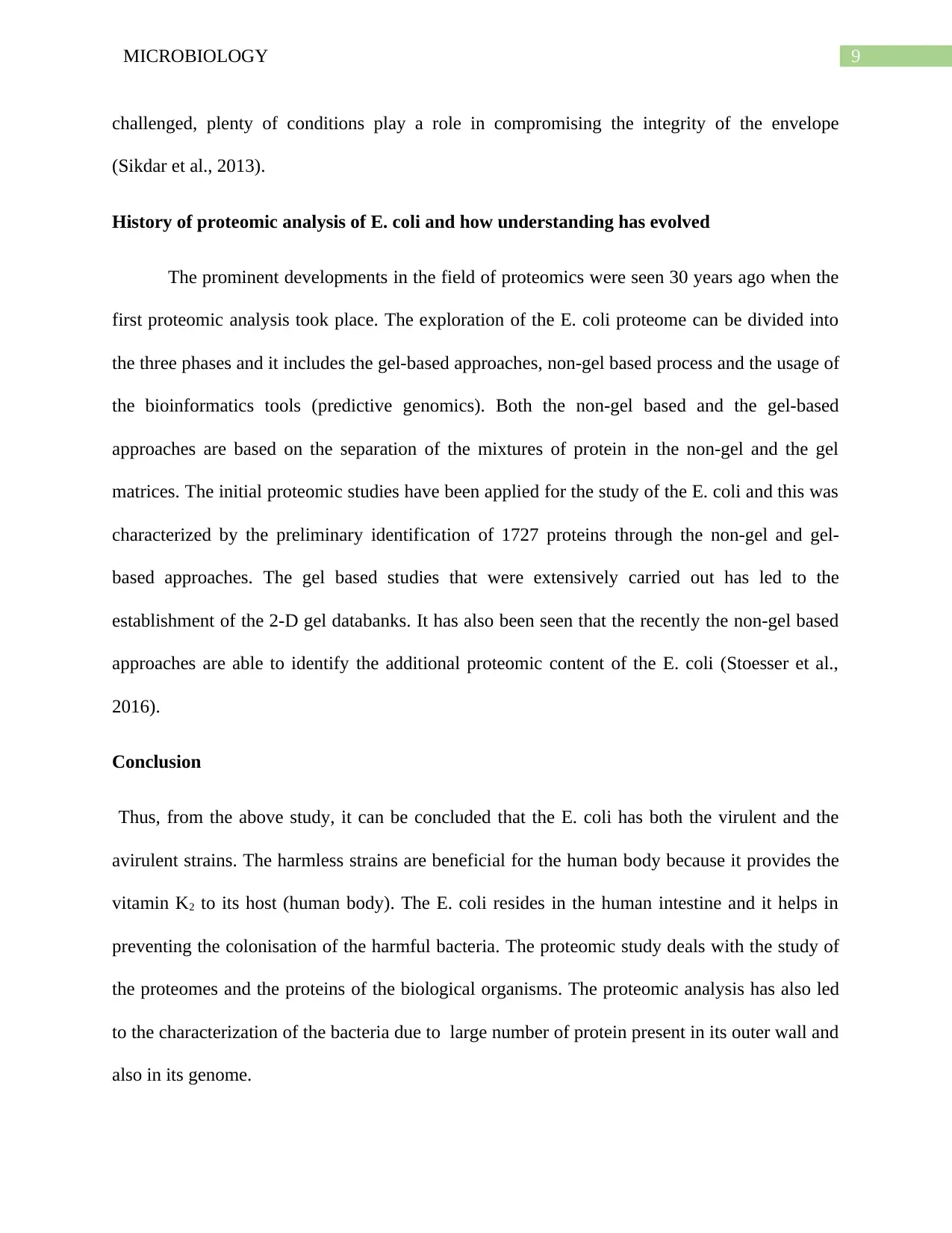
9MICROBIOLOGY
challenged, plenty of conditions play a role in compromising the integrity of the envelope
(Sikdar et al., 2013).
History of proteomic analysis of E. coli and how understanding has evolved
The prominent developments in the field of proteomics were seen 30 years ago when the
first proteomic analysis took place. The exploration of the E. coli proteome can be divided into
the three phases and it includes the gel-based approaches, non-gel based process and the usage of
the bioinformatics tools (predictive genomics). Both the non-gel based and the gel-based
approaches are based on the separation of the mixtures of protein in the non-gel and the gel
matrices. The initial proteomic studies have been applied for the study of the E. coli and this was
characterized by the preliminary identification of 1727 proteins through the non-gel and gel-
based approaches. The gel based studies that were extensively carried out has led to the
establishment of the 2-D gel databanks. It has also been seen that the recently the non-gel based
approaches are able to identify the additional proteomic content of the E. coli (Stoesser et al.,
2016).
Conclusion
Thus, from the above study, it can be concluded that the E. coli has both the virulent and the
avirulent strains. The harmless strains are beneficial for the human body because it provides the
vitamin K2 to its host (human body). The E. coli resides in the human intestine and it helps in
preventing the colonisation of the harmful bacteria. The proteomic study deals with the study of
the proteomes and the proteins of the biological organisms. The proteomic analysis has also led
to the characterization of the bacteria due to large number of protein present in its outer wall and
also in its genome.
challenged, plenty of conditions play a role in compromising the integrity of the envelope
(Sikdar et al., 2013).
History of proteomic analysis of E. coli and how understanding has evolved
The prominent developments in the field of proteomics were seen 30 years ago when the
first proteomic analysis took place. The exploration of the E. coli proteome can be divided into
the three phases and it includes the gel-based approaches, non-gel based process and the usage of
the bioinformatics tools (predictive genomics). Both the non-gel based and the gel-based
approaches are based on the separation of the mixtures of protein in the non-gel and the gel
matrices. The initial proteomic studies have been applied for the study of the E. coli and this was
characterized by the preliminary identification of 1727 proteins through the non-gel and gel-
based approaches. The gel based studies that were extensively carried out has led to the
establishment of the 2-D gel databanks. It has also been seen that the recently the non-gel based
approaches are able to identify the additional proteomic content of the E. coli (Stoesser et al.,
2016).
Conclusion
Thus, from the above study, it can be concluded that the E. coli has both the virulent and the
avirulent strains. The harmless strains are beneficial for the human body because it provides the
vitamin K2 to its host (human body). The E. coli resides in the human intestine and it helps in
preventing the colonisation of the harmful bacteria. The proteomic study deals with the study of
the proteomes and the proteins of the biological organisms. The proteomic analysis has also led
to the characterization of the bacteria due to large number of protein present in its outer wall and
also in its genome.
Paraphrase This Document
Need a fresh take? Get an instant paraphrase of this document with our AI Paraphraser

10MICROBIOLOGY
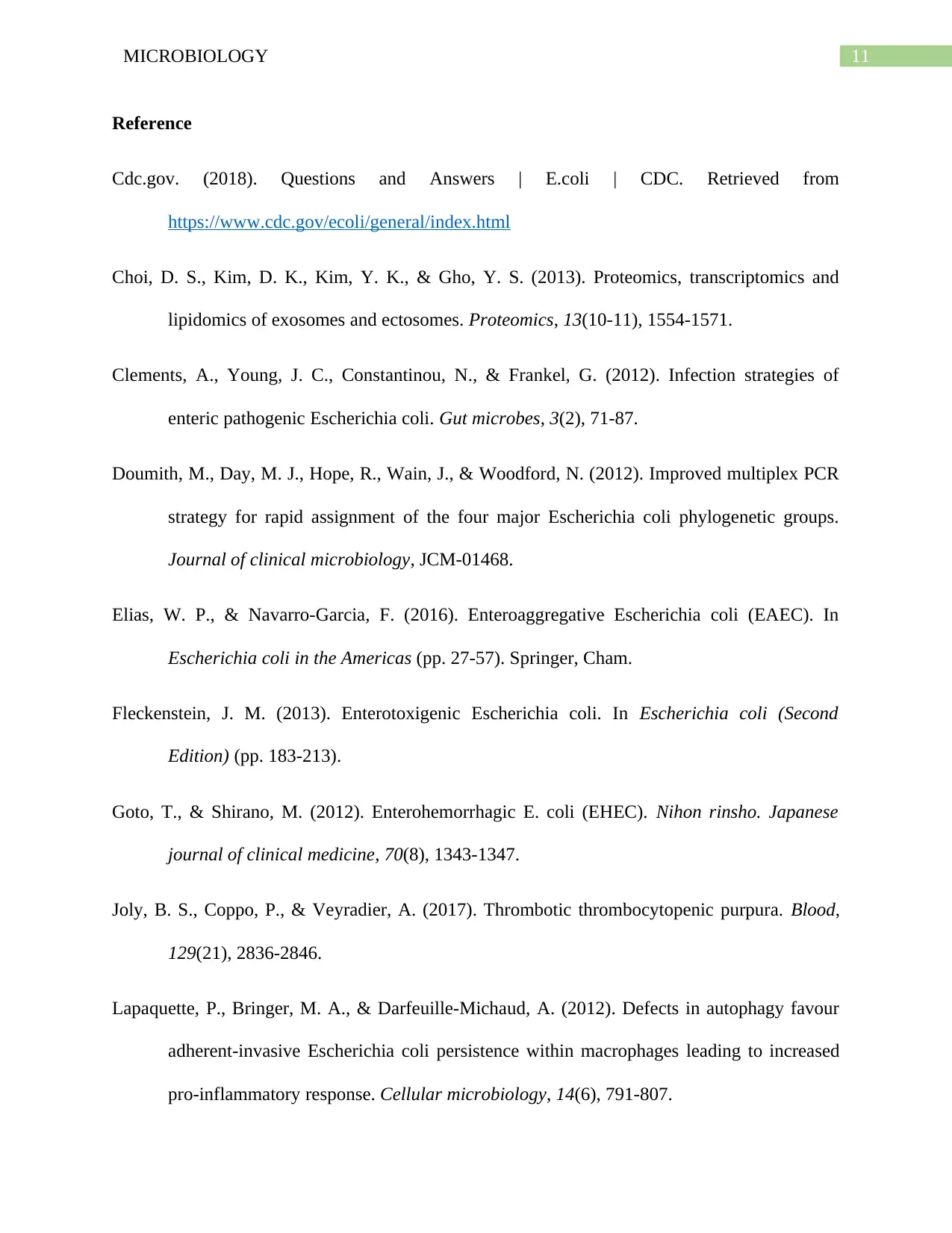
11MICROBIOLOGY
Reference
Cdc.gov. (2018). Questions and Answers | E.coli | CDC. Retrieved from
https://www.cdc.gov/ecoli/general/index.html
Choi, D. S., Kim, D. K., Kim, Y. K., & Gho, Y. S. (2013). Proteomics, transcriptomics and
lipidomics of exosomes and ectosomes. Proteomics, 13(10-11), 1554-1571.
Clements, A., Young, J. C., Constantinou, N., & Frankel, G. (2012). Infection strategies of
enteric pathogenic Escherichia coli. Gut microbes, 3(2), 71-87.
Doumith, M., Day, M. J., Hope, R., Wain, J., & Woodford, N. (2012). Improved multiplex PCR
strategy for rapid assignment of the four major Escherichia coli phylogenetic groups.
Journal of clinical microbiology, JCM-01468.
Elias, W. P., & Navarro-Garcia, F. (2016). Enteroaggregative Escherichia coli (EAEC). In
Escherichia coli in the Americas (pp. 27-57). Springer, Cham.
Fleckenstein, J. M. (2013). Enterotoxigenic Escherichia coli. In Escherichia coli (Second
Edition) (pp. 183-213).
Goto, T., & Shirano, M. (2012). Enterohemorrhagic E. coli (EHEC). Nihon rinsho. Japanese
journal of clinical medicine, 70(8), 1343-1347.
Joly, B. S., Coppo, P., & Veyradier, A. (2017). Thrombotic thrombocytopenic purpura. Blood,
129(21), 2836-2846.
Lapaquette, P., Bringer, M. A., & Darfeuille‐Michaud, A. (2012). Defects in autophagy favour
adherent‐invasive Escherichia coli persistence within macrophages leading to increased
pro‐inflammatory response. Cellular microbiology, 14(6), 791-807.
Reference
Cdc.gov. (2018). Questions and Answers | E.coli | CDC. Retrieved from
https://www.cdc.gov/ecoli/general/index.html
Choi, D. S., Kim, D. K., Kim, Y. K., & Gho, Y. S. (2013). Proteomics, transcriptomics and
lipidomics of exosomes and ectosomes. Proteomics, 13(10-11), 1554-1571.
Clements, A., Young, J. C., Constantinou, N., & Frankel, G. (2012). Infection strategies of
enteric pathogenic Escherichia coli. Gut microbes, 3(2), 71-87.
Doumith, M., Day, M. J., Hope, R., Wain, J., & Woodford, N. (2012). Improved multiplex PCR
strategy for rapid assignment of the four major Escherichia coli phylogenetic groups.
Journal of clinical microbiology, JCM-01468.
Elias, W. P., & Navarro-Garcia, F. (2016). Enteroaggregative Escherichia coli (EAEC). In
Escherichia coli in the Americas (pp. 27-57). Springer, Cham.
Fleckenstein, J. M. (2013). Enterotoxigenic Escherichia coli. In Escherichia coli (Second
Edition) (pp. 183-213).
Goto, T., & Shirano, M. (2012). Enterohemorrhagic E. coli (EHEC). Nihon rinsho. Japanese
journal of clinical medicine, 70(8), 1343-1347.
Joly, B. S., Coppo, P., & Veyradier, A. (2017). Thrombotic thrombocytopenic purpura. Blood,
129(21), 2836-2846.
Lapaquette, P., Bringer, M. A., & Darfeuille‐Michaud, A. (2012). Defects in autophagy favour
adherent‐invasive Escherichia coli persistence within macrophages leading to increased
pro‐inflammatory response. Cellular microbiology, 14(6), 791-807.
⊘ This is a preview!⊘
Do you want full access?
Subscribe today to unlock all pages.

Trusted by 1+ million students worldwide
1 out of 14
Related Documents
Your All-in-One AI-Powered Toolkit for Academic Success.
+13062052269
info@desklib.com
Available 24*7 on WhatsApp / Email
![[object Object]](/_next/static/media/star-bottom.7253800d.svg)
Unlock your academic potential
Copyright © 2020–2025 A2Z Services. All Rights Reserved. Developed and managed by ZUCOL.





